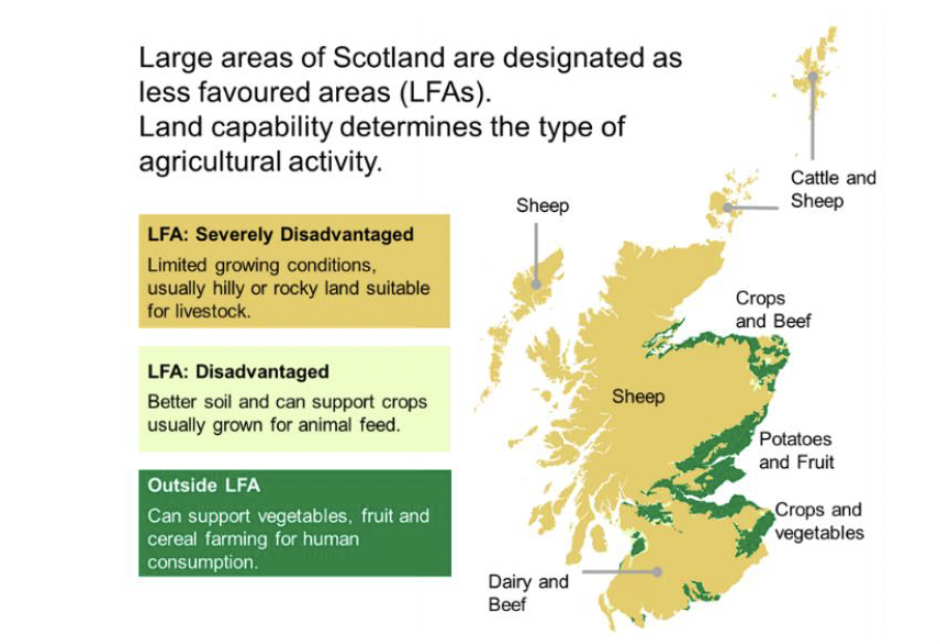Agriculture and Rural Communities (Scotland) Bill: supporting evidence and analysis
This report outlines the current position of the Scottish agricultural sector, with evidence aligned to the objectives in our Vision for Agriculture, and provides information on our approach to assessing new policy proposals as they are taken through secondary legislation.
2.1 Introduction to the Scottish Agricultural Economy
Around 80% of Scottish land is used for agriculture (in the widest sense of being managed for production) according to the agricultural census, although the intensity with which this land is used varies dramatically. The share of land in Scotland used for agriculture has remained fairly stable over the past century, although farming practices and productivity have changed substantially. The utilisable agricultural area in Scotland is 5.5 million hectares of which around 3.7 million hectares are currently claimed on via Basic Payments.
Around 80% of Scottish land is used for agriculture
Agricultural output is generally dependent on land capability. Areas with limited growing conditions are currently designated as Less Favourable Areas (LFAs) in recognition of:
- the presence of land of poor productivity, which is difficult to cultivate and with a limited potential which cannot be increased except at excessive cost, and which is mainly suitable for extensive livestock farming;
- lower than average production, compared to the main indices of economic performance in agriculture;
- a low or dwindling population predominantly dependent on agricultural activity, the accelerated decline of which could cause rural depopulation
Figure 2 shows the primary land use in different areas of Scotland classified by land type.Around 10% of Scottish agricultural land is used to grow cereals, fruit and vegetables. Barley and wheat are the main cereal crops grown in Scotland, accounting for around 85% of the area of crop-land and much of it goes into the production of malting wheat and barley. For example, in 2019 just over half (53%) of Scottish barley was sold to merchants for malting. According to the Scotch Whisky Association, around 90% of barley requirements of the industry are sourced in Scotland.

Just as the quality of land for different types of agricultural activity varies across Scotland, so too does its potential to store carbon in peat and support the expansion of woodland. These activities can help reduce greenhouse gas emissions. Annex C includes maps showing: land capability for agriculture (1 is the highest quality, 8 is the lowest); peat coverage; sites of scientific interest and conservation areas; and suitability of land for woodland expansion.
The Scottish agricultural workforce was just over 67,000 people in 2021 and accounted for around 1% of Scotland’s economy in terms of value added. However, the size of the agriculture sector varies considerably across Scotland and it also underpins other large industries in Scotland including food manufacturing, retail and tourism. For example, outputs of Scotland’s agricultural industries provide a key source of inputs for the wider food supply chain. In 2021, Scotland’s Food and Drink Growth Sector generated turnover of around £14.7 billion and employed around 129,000 people.
Nearly 70,000 people are employed in agriculture across Scotland
Analysis of Scottish Government input-output tables demonstrates the wider contribution of agriculture to the Scottish economy. Agriculture indirectly supports other industries through supply chain effects and the spending of wages. These are known as multiplier effects. The output multiplier for agriculture in the Scottish input-output tables has typically been around 50% over the past 20 years. This would mean that £10 million in activity in the agricultural sector, would typically generate a further £5 million in activity in other sectors of the Scottish economy.
The agricultural sector receives a significant amount of financial support from the Scottish Government, through the Common Agricultural Policy. The Scottish Government’s agricultural support budget consists of £485 million in Pillar 1 payments and around £130 million in Pillar 2 payments in 2023-24. Analysis by SRUC estimated the proportion of direct support payments by agricultural source in 2019. This included the Basic Payment Scheme, Scottish Suckler Beef Support Scheme, Scottish Upland Sheep Support Scheme, the Beef Efficiency Scheme and the Less Favoured Area Support Scheme (over £500 million in total). The estimated share of direct support payments by agricultural source is shown in Table 1.
Source |
Share of Direct Support |
|---|---|
Beef |
44% |
Crop |
25% |
Sheep |
24% |
Dairy |
5% |
Grazing or fodder without (June) stocking activity |
3% |
Total |
100% |
Source: Estimation of sectoral CAP payment ‘envelopes’ and distribution of agri-environment and forestry support 2019 (SRUC), doesn’t sum to 100% due to rounding.
Contact
Email: richard.haw@gov.scot
There is a problem
Thanks for your feedback